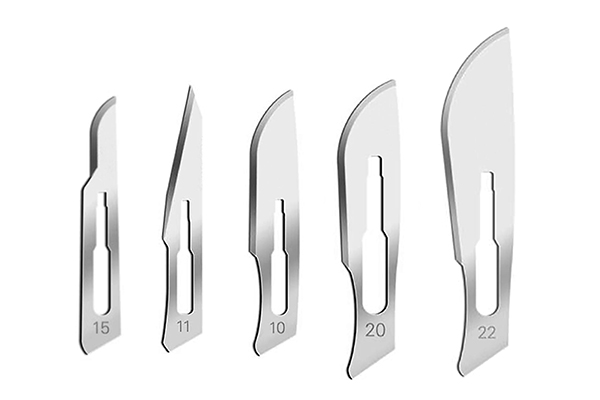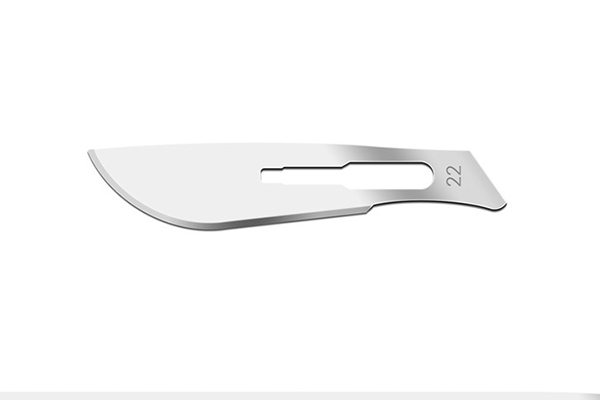For centuries, surgeons have relied on the keen edge of steel scalpels. But what if a sharper, more precise cutting tool lay hidden in the volcanic past? This article delves into the intriguing world of the obsidian scalpel, exploring its remarkable sharpness, potential for improved wound healing, and the ongoing debate surrounding its use in modern surgery. Discover why this ancient material is sparking renewed interest among surgeons and procurement managers alike.
What is an Obsidian Blade and Why is it Getting Attention in Surgery?
Obsidian is a naturally occurring volcanic glass formed when felsic lava cools rapidly with minimal crystal growth. This rapid cooling process results in an amorphous structure, giving obsidian an incredibly smooth and uniform texture at a microscopic level. For millennia, this readily available material was used by early humans to create exceptionally sharp tools and knives. Fast forward to modern medicine, and the inherent sharpness of obsidian is drawing renewed attention from surgeons. The potential for cleaner incisions and improved patient outcomes is a significant driver behind this interest. While surgical steel remains the standard, the promise of a superior cutting edge is hard to ignore.
The buzz around obsidian blade technology in surgery stems from its potential to make incredibly fine and precise cuts. Imagine a scalpel that can slice with such accuracy that it minimizes cellular damage. This isn’t just theoretical; the unique formation of volcanic glass allows for an edge that can be significantly sharper than even the finest steel scalpel blade. This has led to discussions and even some studies exploring whether the use obsidian scalpels could lead to better outcomes in certain surgical procedures.
Obsidian Scalpel vs. Surgical Steel Scalpel: What’s the Difference in Sharpness?
To truly understand the allure of the obsidian scalpel, we need to delve into the microscopic details of its edge compared to that of a traditional surgical steel scalpel. Even the sharpest surgical steel has a somewhat irregular, serrated edge when viewed under an electron microscope. This is due to the crystalline structure of the metal. In contrast, the amorphous structure of obsidian allows for a far more uniform and smoother edge, sometimes measured at just 30 angstroms – an incredibly fine dimension.
This difference in edge structure translates directly to cutting performance. While a steel blade might tear or crush tissue at a microscopic level, an obsidian blade is believed to slice more cleanly, potentially leading to less trauma. Consider the impact on delicate tissue during surgery. The smoother cut of an obsidian scalpel could mean less cellular damage and a smoother healing process. This fundamental difference in sharpness is the core of the obsidian advantage.

How Many Times Sharper is an Obsidian Scalpel Blade Compared to a Steel Scalpel?
The question of how many times sharper an obsidian scalpel blade is compared to a steel scalpel is a frequent one, and the answer often cited is quite striking. Studies using atomic force microscopy have indicated that the edge of an obsidian blade can be 6-18 times sharper than a conventional steel blade. Some sources even suggest figures as high as many times sharper. However, it’s important to note that quantifying sharpness precisely can be complex and depends on the measurement methods used.
Even a conservative estimate highlights the significant difference. Think about the implications for the surgeon. A sharper blade requires less force to make an incision, potentially leading to greater precision and control, particularly in delicate procedures. For Mark Thompson, a hospital procurement manager, this translates to potentially better surgical outcomes and reduced complications. While the numbers are impressive, it’s crucial to understand how this translates to tangible benefits in the operating room.
Can Using Obsidian Scalpels Really Lead to Better Wound Healing and Less Scarring?
The remarkable sharpness of obsidian scalpels naturally leads to the question of whether they can improve wound healing and reduce scar formation. The theory is compelling: a cleaner, more precise incision with less tissue trauma should, in principle, lead to a smoother healing process. There are several anecdotal clinical articles claiming improved wound healing and scar superiority when using obsidian. These often highlight cases with minimal inflammation and less visible scarring.
One study, published on pubmed, compared skin incisions made with obsidian and steel surgical blades in rats. The results showed that wounds created with obsidian exhibited fewer inflammatory cells and less granulation tissue at 7 and 14 days post-incision compared to those made with steel. While animal studies don’t directly translate to human outcomes, they provide valuable insights. However, it’s important to acknowledge that rigorous, large-scale clinical trials in humans are still needed to definitively prove the clinical superiority of obsidian in terms of wound healing. The allure of less scarring is a significant driver in the ongoing investigation of uses obsidian.
What Does Research Say About the Use of Obsidian Scalpels by Surgeons?
While the sharpness of obsidian is well-established, the body of formal research on its clinical use by surgeons is still developing. The rat study mentioned previously provides some scientific basis for the anecdotal claims. However, large-scale, randomized controlled trials in human subjects are needed to provide definitive evidence of improved outcomes. Many of the existing claims about wound healing and scar superiority come from anecdotal clinical articles claiming wound improvements observed by individual surgeons.
It’s important to approach these anecdotes with a degree of caution. As one comment on a Reddit thread aptly put it, "reddit is anonymous, get a name on that research!" While personal experiences can be valuable, they lack the rigor of controlled studies. The scientific community needs more peer-reviewed publications in reputable journals like the American Medical Association’s publications to fully assess the efficacy of obsidian scalpels. Further research should focus on comparing outcomes of specific surgical procedures using both obsidian and stainless steel scalpels.

Are There Any Downsides or Limitations to Using Obsidian Scalpels in Surgery?
Despite the impressive sharpness, obsidian is inherently brittle. This is a significant concern when considering its use in the demanding environment of the operating room. Unlike the more ductile surgical steel, brittle obsidian is more prone to chipping or flakeing under pressure, especially lateral pressure. This brittleness necessitates careful handling and specialized techniques by the surgeon.
Another practical consideration is the cost and availability of obsidian scalpel blades. They are not as widely manufactured or readily available as stainless steel scalpels. Ensuring a consistent supply and managing potential breakage are key logistical challenges. Furthermore, the tactile feedback experienced by surgeons when using obsidian may differ from that of steel, requiring a learning curve. While the edge of obsidian is incredibly fine, this very thinness can also contribute to its fragility. For hospital procurement, these factors need careful consideration.
Who is Using Obsidian Scalpels Today and Where Can Surgeons Use Them?
While not yet a mainstream surgical tool, obsidian scalpels are finding niche applications where their exceptional sharpness offers distinct advantages. They are sometimes used in delicate procedures, particularly in ophthalmology and cosmetic surgery, where minimizing tissue trauma and scar tissue is paramount. Some veterinary surgeons also uses obsidian for its precise cutting ability.
The precision offered by obsidian can be particularly beneficial in procedures requiring fine dissections or where minimizing cellular damage is critical. The potential for improved healing makes them attractive for procedures where scar formation is a significant concern for the patient. However, widespread adoption is still limited by factors like brittleness and the need for specialized training. It’s worth noting that hand made obsidian knives have been used in research settings for specific types of tissue sectioning due to their ultra-sharp edge.
For Procurement Managers Like Mark Thompson, What are the Key Considerations for Obsidian Scalpels?
For procurement managers like Mark Thompson, the decision to adopt obsidian scalpels involves a careful evaluation of several factors. Quality assurance is paramount. Ensuring the obsidian scalpel blades are manufactured to the highest standards and undergo rigorous quality control is crucial. Sterility validation is also essential, just as it is for any surgical instruments. Certifications, such as ISO 13485 and CE marking, are vital for compliance with medical regulations.
Cost is another significant consideration. Obsidian scalpels are likely to be more expensive than traditional steel surgical blades due to the specialized manufacturing process. Breakage rates and the need for potentially more frequent replacements must be factored into the overall cost analysis. Logistics and the reliability of the supplier are also important, especially for ensuring a consistent supply. Finally, understanding the specific needs of the surgeons and the potential clinical benefits for patients is crucial in making an informed decision.
How Can Medical Distributors and Wholesalers Benefit from Offering Obsidian Scalpels?
Medical distributors and wholesalers have an opportunity to position themselves at the forefront of innovation by offering obsidian scalpels. While the market may be niche currently, the potential for growth is significant as more research emerges and surgeons become aware of the benefits. Offering obsidian scalpels can differentiate a supplier and attract clients seeking cutting-edge technology.
Highlighting the potential for improved patient outcomes and reduced scarring can be a strong selling point. Providing comprehensive information about the sharpness, sterility, and proper handling of obsidian scalpels is crucial for building trust and encouraging adoption. Collaborating with manufacturers who adhere to strict quality standards is essential for ensuring the reliability and safety of the product. For B2B businesses like ours, understanding the evolving needs of hospitals and clinics allows us to offer valuable and innovative solutions.
Where Can Hospitals and Clinics Source High-Quality Obsidian Scalpels?
Sourcing high-quality obsidian scalpels requires careful vetting of manufacturers and suppliers. Hospitals and clinics should prioritize suppliers who can provide evidence of rigorous quality control, sterility validation, and compliance with relevant medical device regulations. Looking for certifications like ISO 13485 and CE marking is a good starting point.
Direct engagement with manufacturers who specialize in hand made or precisely machined obsidian blades may be necessary, as they are not yet a commodity item offered by all surgical instruments suppliers. Attending medical device and healthcare exhibitions can be a valuable way to connect with potential suppliers and learn about the latest advancements in surgical technology. Thorough due diligence, including requesting samples and verifying certifications, is crucial before establishing a supply relationship.
Key Takeaways:
- Obsidian blades are significantly sharper than traditional steel scalpels, potentially offering greater surgical precision.
- Early research and anecdotal evidence suggest potential benefits in wound healing and reduced scarring, but more robust clinical trials are needed.
- Brittleness is a key limitation of obsidian, requiring careful handling and potentially leading to higher breakage rates.
- Obsidian scalpels are currently used in niche applications, particularly where minimizing tissue trauma is critical.
- Procurement managers must consider factors like cost, quality, sterility, and supplier reliability when evaluating obsidian scalpels.
- Medical distributors have an opportunity to offer a cutting-edge technology with the potential for improved patient outcomes.
- Sourcing high-quality obsidian scalpels requires careful vetting of manufacturers and a focus on certifications and quality assurance.
Learn more about our high-quality medical cotton swabs.
Explore our range of medical gauze bandages.
View our selection of sterile sutures with needles.
Post time: 1月-17-2025





